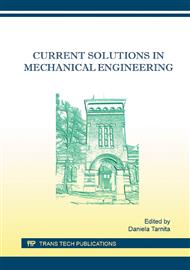p.3
p.7
p.13
p.17
p.23
p.30
p.37
p.43
p.49
Some Considerations about the Influence of the Stress Intensity Factors KImin, KIImax and Keq in Fatigue Crack Propagation in the Substrate of the Gear Teeth
Abstract:
The values of the stress intensity factor (SIF) KI are almost always negative in the substrate of the gear teeth, due to the compressive stresses field. The more negative values are higher, respectively, the positive values are lower, the crack faces are more compressed, so the probability of crack propagation after the mode I is lower. Thus, the analysis of the factors leading to the minimum KI values may reveal the conditions that favor the fatigue crack propagation by opening mode. Instead, SIF KII is determinant in the growth rate of the fatigue crack by mode II, in terms of compressive stresses field. Thus, the more KII is higher, the propagation speed is higher, so an analysis of the factors that lead to its maximum value is very useful. The equivalent stress intensity factor Keq corresponds to a mixed-mode of loading and take into account the simultaneous influence of both stress intensity factors KI and KII. The variation of this factor can be used as a parameter of the modified Paris law, in order to study the propagation of the fatigue cracks in the case of mixed-mode loading of contact area between teeth flanks. SIFs variations were analyzed according to the state of stresses, position on the pitch line between the gear teeth flanks, position and angle of an initial crack in the gear tooth substrate, residual tensions etc.
Info:
Periodical:
Pages:
23-29
Citation:
Online since:
January 2016
Authors:
Price:
Сopyright:
© 2016 Trans Tech Publications Ltd. All Rights Reserved
Share:
Citation:


